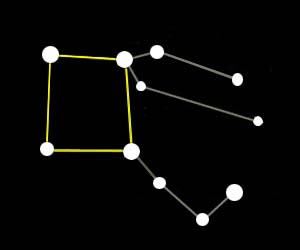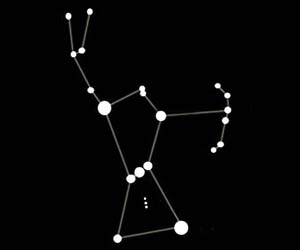
Once upon a time, every constellation had a backstory. Wait, every constellation does have a backstory! Have you ever wondered how these stories came to be or why some of them might be a little different? Let’s begin with the basics. What’s a constellation? It’s any group of stars that is easily recognizable and is named after what it may look like or resemble. People have been looking up at the nighttime sky and giving names to these constellations for as long as people have been able to look up at the sky! Some constellations, though, have a giant list of different names based on what people saw in the stars (very similar to cloud watching) or the culture of those specific people.
 A multitude of recognizable constellations come from Greek mythology. Ever hear of Cancer the Crab? How about Pegasus the Winged Horse? Or Hercules the Hero? All of these are constellations that came from Greek legend each with their own fable or star story. Another well-known constellation is that of Orion the Hunter and can be seen in the winter sky in the northern hemisphere, indicating that winter is coming. Story tells that Orion was one of the greatest hunters who had ever lived and there are many different versions of how he ended up in the sky, but in every Greek version he was known as Orion.
A multitude of recognizable constellations come from Greek mythology. Ever hear of Cancer the Crab? How about Pegasus the Winged Horse? Or Hercules the Hero? All of these are constellations that came from Greek legend each with their own fable or star story. Another well-known constellation is that of Orion the Hunter and can be seen in the winter sky in the northern hemisphere, indicating that winter is coming. Story tells that Orion was one of the greatest hunters who had ever lived and there are many different versions of how he ended up in the sky, but in every Greek version he was known as Orion.
 In other places and cultures, the constellation that the Greeks named Orion had different names, but was still known as a great hunter. The Chinese called him “Shen”. In old Hungarian tradition, he was known as “Archer”. The stars of Orion’s belt were also known by some different names. The Scandinavians associated the Orion constellation with the goddess Freya and referred to Orion’s belt as “Frigg’s Distaff”. In Spain and Latina America, the three stars of the belt are called “Las Tres Marí” (Spanish for “The Three Marys”). Some cultures had completely different descriptions, such as the Babylonians of the Late Bronze Age. They knew Orion as “The Heavenly Shepherd” or “The True Shepherd of Anu”, with Anu being the god of the heavenly realms. Egyptians associated Orion with Unas, the last Pharaoh of the Fifth Dynasty.
In other places and cultures, the constellation that the Greeks named Orion had different names, but was still known as a great hunter. The Chinese called him “Shen”. In old Hungarian tradition, he was known as “Archer”. The stars of Orion’s belt were also known by some different names. The Scandinavians associated the Orion constellation with the goddess Freya and referred to Orion’s belt as “Frigg’s Distaff”. In Spain and Latina America, the three stars of the belt are called “Las Tres Marí” (Spanish for “The Three Marys”). Some cultures had completely different descriptions, such as the Babylonians of the Late Bronze Age. They knew Orion as “The Heavenly Shepherd” or “The True Shepherd of Anu”, with Anu being the god of the heavenly realms. Egyptians associated Orion with Unas, the last Pharaoh of the Fifth Dynasty.
 The names of constellations and the stories behind them are not set in stone. There is no name or story that is right and there is no name or story that is wrong. The most intriguing aspect is that despite all the different names and stories, different cultures still saw the same pattern in the sky and most used it as a reference of time, indicating winter in the northern hemisphere and summer in the southern hemisphere. When you get the opportunity, I encourage you to take a look at some blank constellations. Discover what you see in the stars!
The names of constellations and the stories behind them are not set in stone. There is no name or story that is right and there is no name or story that is wrong. The most intriguing aspect is that despite all the different names and stories, different cultures still saw the same pattern in the sky and most used it as a reference of time, indicating winter in the northern hemisphere and summer in the southern hemisphere. When you get the opportunity, I encourage you to take a look at some blank constellations. Discover what you see in the stars!
http://www.space.com/16659-constellation-orion.html
http://www.constellation-guide.com/constellation-list/orion-constellation/


